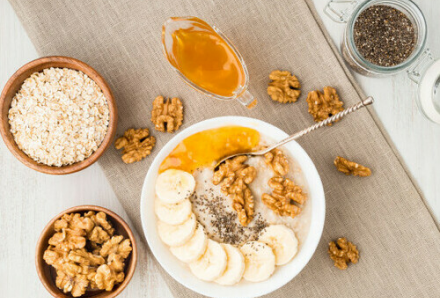Getting enough fiber is a lot like other healthy habits like having a balanced diet and exercising regularly—we know we should be doing it but somehow, we still don’t. Maybe it’s a lack of time or sheer laziness, or maybe it seems overwhelming. But adding high-fiber foods to your diet isn’t all that difficult, especially since there are those you can simply sprinkle onto what you already eat for an extra fiber punch.
Find out why fiber is so important in the first place and how you can increase your fiber intake.
Fiber Basics
Fiber is the portion of plant-derived foods that cannot be digested by the body. When you consume fruits, vegetables, and grains, your body absorbs the nutrients for use while the rest passes through the body and is eliminated through bowel movement.
The two types of fiber are soluble and insoluble. Soluble fiber dissolves in water and slows digestion, making the body more efficient at absorbing nutrients and making you feel full for longer. Insoluble fiber bulks up stool, letting waste pass more easily through the system.
High-Fiber Diet Benefits
Fiber is primarily associated with digestive health as it promotes regular bowel movement and helps keep stomach issues—such as as gastroesophageal reflux disease, constipation, and hemorrhoids—at bay. A 2017 study also suggests that fiber even plays a role in the gut microbiome, helping good bacteria to thrive.
But because all the systems in the body are intricately connected, a high-fiber diet has positive effects beyond improving digestion. Some of the other benefits of eating more fiber are:
Lowers risk of heart disease. According to Harvard Health Publishing, soluble fiber “binds cholesterol and its precursors in the digestive system and drags them out of the body before they get into circulation.” Having lower cholesterol means a lower risk of heart disease.
Lowers risk of diabetes. Eating plenty of fiber can help slow down the absorption of sugar, causing fewer spikes in blood sugar and ultimately lowering the risk of diabetes. (Note that this isn’t your free pass to binge on sugar! A healthy diet and lifestyle is still the best protection against diabetes.)
Prevents kidney stones and gallstones. By slowing down the absorption of blood sugar, fiber prevents insulin spikes which can lead to the development of kidney stones and gallstones.
Foods to Increase Fiber Intake
Upping your intake of fruits and vegetables is a good place to start. But if you’re not ready for an overhaul of your diet, then simply add these high-fiber foods to your existing diet:
Chia seeds. According to the Harvard T.H. Chan School of Public Health, the fiber in chia seeds is mainly soluble fiber and mucilage and “may help to lower LDL cholesterol and slow down digestion, which can prevent blood sugar spikes after eating a meal and promote a feeling of fullness.” Aside from having 11 grams of fiber per two tablespoons, chia seeds are also the richest plant source of omega-3 fatty acids, are a complete protein, and also contain calcium.
Add them to your diet: Sprinkle them onto salads, smoothies, or yogurt; add them to your morning cereal or oats; have some chia pudding for a snack. Because chia seeds have a neutral taste, the possibilities are endless.
Oats. Oatmeal is a “desired asset to those trying to lose weight and control hunger levels due to its high water and soluble fiber content,” states the Harvard T.H. Chan School of Public Health. Studies have also shown that, when taken with other whole grains, oats may prevent heart disease, diabetes, and improve digestive health.
There are a number of different types of oats, from steel-cut to quick-cooking. They’re all nutritionally comparable so picking the type of oats for you depends largely on the amount of prep time you have and your preferred texture.
Add them to your diet: If oatmeal is a little too bland for your taste, try topping it with your favorite fruit (added fiber!). You can also use them make overnight oats, mix them with your favorite cereal, or use them to make breads and cookies.
Sunflower seeds. Nutrient-rich sunflower seeds don’t just contain fiber but are also rich in healthy fats. They also contain protein, Vitamin E, folate, phosphorus, and number of other vitamins and minerals.
Add them to your diet: You can snack sunflower seeds like butong pakwan—just crack the shell open and munch the contents. You can sprinkle de-shelled sunflower seeds onto breakfast cereal, oatmeal, soups, and salads. You can even make sunflower seed butter using the seeds, salt, sugar, and sunflower oil.
sources:





